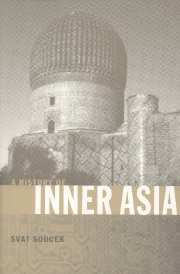Book contents
- Frontmatter
- Contents
- List of maps
- Preface
- Introduction
- 1 The beginnings
- 2 The Kök Turks, the Chinese expansion, and the Arab conquest
- 3 The Samanids
- 4 The Uighur kingdom of Qocho
- 5 The Qarakhanids
- 6 Seljukids and Ghaznavids
- 7 The conquering Mongols
- 8 The Chaghatayids
- 9 Timur and the Timurids
- 10 The last Timurids and the first Uzbeks
- 11 The Shaybanids
- 12 The rise of Russia, the fall of the Golden Horde, and the resilient Chaghatayids
- 13 The Buddhist Mongols
- 14 Bukhara, Khiva, and Khoqand in the seventeenth to nineteenth centuries
- 15 The Russian conquest and rule of Central Asia
- 16 From Governorates-General to Union Republics
- 17 Soviet Central Asia
- 18 Central Asia becomes independent
- 19 Sinkiang as part of China
- 20 Independent Central Asian Republics
- 21 The Republic of Mongolia
- Summary and conclusion
- Appendix 1 Dynastic tables
- Appendix 2 Country data
- Select bibliography
- Index
18 - Central Asia becomes independent
Published online by Cambridge University Press: 05 June 2012
- Frontmatter
- Contents
- List of maps
- Preface
- Introduction
- 1 The beginnings
- 2 The Kök Turks, the Chinese expansion, and the Arab conquest
- 3 The Samanids
- 4 The Uighur kingdom of Qocho
- 5 The Qarakhanids
- 6 Seljukids and Ghaznavids
- 7 The conquering Mongols
- 8 The Chaghatayids
- 9 Timur and the Timurids
- 10 The last Timurids and the first Uzbeks
- 11 The Shaybanids
- 12 The rise of Russia, the fall of the Golden Horde, and the resilient Chaghatayids
- 13 The Buddhist Mongols
- 14 Bukhara, Khiva, and Khoqand in the seventeenth to nineteenth centuries
- 15 The Russian conquest and rule of Central Asia
- 16 From Governorates-General to Union Republics
- 17 Soviet Central Asia
- 18 Central Asia becomes independent
- 19 Sinkiang as part of China
- 20 Independent Central Asian Republics
- 21 The Republic of Mongolia
- Summary and conclusion
- Appendix 1 Dynastic tables
- Appendix 2 Country data
- Select bibliography
- Index
Summary
By the time Gorbachev became First Secretary of the Communist Party of the Soviet Union in 1985, people knew that his country had serious economic, social, and perhaps even military problems. The inherent flaws of the system had begun to sap its strength to a point where some of its leaders started wondering whether modifications were necessary, and if so, what kind and to what extent.
One problem was corruption among high officials. For some reason this corruption turned out to be especially rampant in Central Asia, and worst in Uzbekistan. Sharaf Rashidov (1917–83) was since 1959 First Secretary of the republic's Communist Party, and in 1961 Moscow showed its trust in this Uzbek by elevating him to membership in the system's highest political aristocracy, the CC CPSU (Central Committee of the Communist Party of the Soviet Union). He retained both posts until his death in 1983, and when he died he was buried with honors comparable only to those of his role models, Lenin and Stalin: his body was placed in a mausoleum built for that purpose on the Uzbek capital's main square.
Rashidov of course had to earn Moscow's trust, and there was ample opportunity to do that. His record as a perfect Party member was impeccable, and the rulers in the Soviet capital knew that they could count on his cooperation in their control of Uzbekistan as an obedient republic.
- Type
- Chapter
- Information
- A History of Inner Asia , pp. 254 - 262Publisher: Cambridge University PressPrint publication year: 2000

